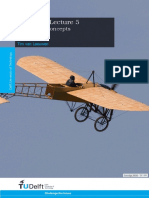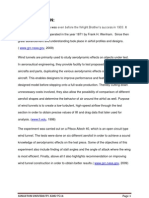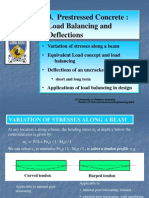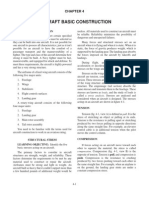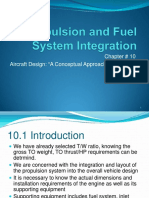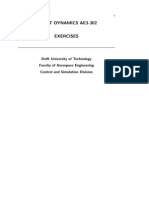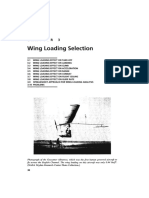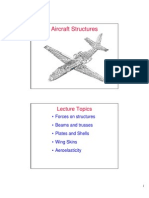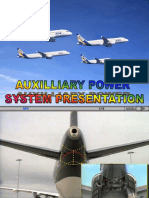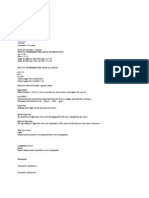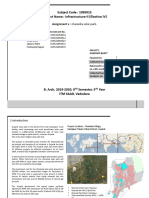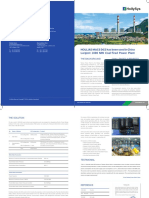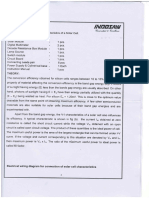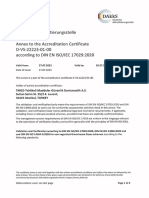Fluid Mechanics II: B.S. Mechanical Engineering 4 Semester
Fluid Mechanics II: B.S. Mechanical Engineering 4 Semester
Uploaded by
naeema_58Copyright:
Available Formats
Fluid Mechanics II: B.S. Mechanical Engineering 4 Semester
Fluid Mechanics II: B.S. Mechanical Engineering 4 Semester
Uploaded by
naeema_58Original Description:
Original Title
Copyright
Available Formats
Share this document
Did you find this document useful?
Is this content inappropriate?
Copyright:
Available Formats
Fluid Mechanics II: B.S. Mechanical Engineering 4 Semester
Fluid Mechanics II: B.S. Mechanical Engineering 4 Semester
Uploaded by
naeema_58Copyright:
Available Formats
B.S.
Mechanical Engineering
4
th
Semester
Boundary Layer Theory
EXTERNAL FLOW CHARACTERISTICS
1. Flow may be steady or unsteady
2. Flow depends on the nature of the body
a. Two dimensional objects
b. Axisymmetric bodies
c. Three dimensional bodies
3. Flow depends on the shape of the body
a. Streamlined Bodies
b. Blunt Bodies
2 D body
Axisymmetric body 3D body
Blunt
Streamlined Streamlined
2
Related Equations of Flow
Continuity Eq
Momentum Eq
3
Lift and Drag
4
Flow field is a function of shape of the body
For a given shaped object flow field depends on:
Reynolds # and Geometry Effects
In most of situations
For Water or Air
0.01 m < l <10 m
0.01 m/sec < U < 100 m/sec
Gives 10 < Re < 10
9
1. Size
2. Orientation
3. Speed
4. Fluid Properties
Mach Number
Froude Number
Reynolds Number
lV
Re
=
Extreme limits????
For
Re < 1 Viscosity Dominated Flow
Re > 100 Inertia Dominated Flow
Most familiar flows are dominated
by Inertia
Generally, Re >> 1 or Re << 1
5
Reynolds # and Geometry Effects, contd.
Flow over Flat Plate
Flow is viscous in a
Specific Region
and Inviscid
everywhere else
Boundary Layer
6
Reynolds # and Geometry Effects, contd.
Flow over Circular Cylinder
Again Viscous
effects are
contained in a
Specific Region
The Specific
Region is called
Boundary Layer
7
Boundary Layer Properties
Boundary Layer is a region in which
1. Viscous effects are present
2. Velocity Gradients are present and velocity at wall is zero (No slip)
3. Flow velocity increases normal to the surface and reaches U
Thickness of Boundary layer is represented by
Velocity gradient causes generation of shear stress at wall
There is no sharp edge of Boundary layer y= where u = 0.99 U
w
w
u
y
t
| | c
=
|
c
\ .
8
Boundary Layer Properties, cont.
Displacement Thickness o*
It is an index proportional to missing volume flow rate due to presence
of boundary layer
A = Actual flow rate =
B= hypothetical flow rate if BL were not there =
B A = Missing Flow Rate =
0
udy
o
}
0
Udy
o
}
( )
0
U u dy
o
}
Missing Flow Rate may also be expressed as =
*
Uo
Comparing above eqs. We have:
*
0
1
u
dy
U
o
o
| |
=
|
\ .
}
9
Boundary Layer Properties, cont.
Displacement Thickness o*
2. It is the distance through which the external inviscid flow is displaced by
the presence of boundary layer
10
Boundary Layer Properties, cont.
Momentum Thickness u
It is an index proportional to missing momentum due to presence of
boundary layer
A = Actual Momentum flow across dy =
2
u dy
B= hypothetical Momentum flow if BL were not there =
( ) u U u dy
B A = Total Missing Momentum Flow =
( )
0
y
u U u dy
}
Mass flow across a segment dy is as dm udy =
Total Missing Momentum Flow =
2
U u
Comparing above eqs. We have:
0
1
y
u u
dy
U U
u
| |
=
|
\ .
}
It is used for
determining the drag
on the object
11
Karmans Analysis of Flat Plate
Consider a Control Volume
for the Flow over Flat Plate
x- Momentum Eq.
The only force acting is drag due to shear stress at the surface of plate
1. From (0, 0) to (0, h): a one-dimensional inlet, V . n = -U
2. From (0, h) to (L, ): a streamline, no shear, V . n = 0
3. From (L,o ) to (L, 0): a two-dimensional outlet, V . n = +u(y)
4. From (L, 0) to (0, 0): a streamline just above the plate surface, V . n = 0,
shear forces summing to the drag force Di acting from the plate onto
the retarded fluid
As a 1
st
Step We consider the
Integral Analysis of Flat Plate
0
12
Karmans Analysis of Flat Plate, contd.
Now, we need to find
for all sides
It is a streamline and there
must be no flow across
streamline, so
V . n = 0
Side 1
V . n = -U
dA = b dy
u = U
2
( . )
CS
u V n dA U bh =
}
Side 2
( . ) 0
CS
u V n dA =
}
Side 3
V . n = u(y)
dA = b dy
2
0
( . )
CS
u V n dA b u dy
o
=
} }
Side 4
Solid wall so, V . n = 0
Shear force = -D
Hence
2 2
0
x
F D U bh b u dy
o
= = +
}
2 2
0
D U bh b u dy
o
=
}
13
Karmans Analysis of Flat Plate, contd.
As relation b/w h and is not known, so we
must remove h from the result given above
Applying Continuity Equation
Also drag may be calculated from
shear stress distribution
(1)
(2)
Comparing (1) and (2)
Valid for both Laminar &
Turbulent Flows
14
For Laminar Flow, Karman used
following Velocity Profile
Momentum Thickness
comes out to be
Wall Shear
Boundary layer is thin if
/x 0.1 R
ex
= 2500
Karmans Analysis of Flat Plate, contd.
1/ 2
e
2
R
5.5
w
U
x
t =
and
Above relations are valid
for 2500 R
ex
3 x 10
6
(Laminar Flow)
15
Consider the laminar flow of an incompressible fluid past a flat plate at
y = 0. The boundary layer velocity profile is approximated as u = U y/ for
0 y and u = U for y > . Determine the shear stress by using the
momentum integral equation
Example 1 Integral Momentum Analysis
and
so
Hence
16
Boundary Layer Equations
Internal Flows
Approximations introduced to NS result in great simplifications
Only two equations need to be solved in stead of three eqs. (2-D, Isothermal)
Can predict separation
Cannot model separated flows
Analytical solutions of NS Eqs. Exist for Laminar Flow in
Simple Geometries. No solution exists for Turbulent flow
External Flows
No Analytical solutions of NS Eqs. Exist.
Other methods used are:
1. Numerical Solution
2. Experimental
3. BL Theory
Boundary Layer Theory
17
Assumptions
1. 2-D Flow
2. Steady state flow
3. No gravity effects
4. Incompressible flow
Boundary Layer Equations, contd.
Under these Assumptions NS become
To be solved for u, v and p
B.C.s are no-slip; inlet and exit
Too difficult to be solved analytically
For High Reynolds Number Following
Approximations Apply:
18
Boundary Layer Equations, contd.
1. y-Momentum eq. can be entirely ignored
2. Pressure varies only along boundary layer and not through it
3. The pressure-gradient along boundary layer is assumed to be known in
advance from Bernoullis equation applied to the outer inviscid flow
4. The diffusion term in x- Momentum eq. reduces to
5. Continuity equation is still valid
6. Momentum equation becomes:
7. There are two equations only but non-linear
2 2 2
2 2 2
( )
u u u
because
y x y
c c c
<<
c c c
2
2
( )
u u u dU
u v U
x y y dx
v
c c c
+ = +
c c c
Continuity
u v
0
x y
c c
+ =
c c
Momentum Along Wall
u u dU 1
u v U
x y dx y
c c c
+ = +
c c c
BCs
At y=0; u = v= 0
At y=; u = U(x)
19
The Flat Plate Boundary Layer; Laminar Flow
Inviscid flow over a flat plate yields a constant pressure over the surface (from
Bernoullis Eq) so:
Mathematical behavior of above equations is parabolic
Balsius used following transformation
Substituting above transformation in Boundary Layer equations, he got
He solved the above equation:
/ 0 p x c c =
BCs and
20
Solution is self-similar
Shape Factor H is the ratio of
Displacement Thickness to
Momentum Thickness and is given by
Other Results
The Flat Plate Boundary Layer; Laminar Flow
21
Example Flat Plate Boundary Layer
Air flows over a flat plate of length l = 2 ft such that the Reynolds
number based on the plate length is Re = 2x10
5
. Plot the boundary
layer thickness for 0 x l
5
Re 2 10
Ul
u
= =
5 4
Re 2 10 1.57 10
2
15.7 / sec
U
l
ft
v
= =
=
l = 2 ft
Re = 2 x10
5
= 1.57 x 10
-4
ft
2
/s
Flow as laminar as Re < 5 x 10
5
4
1.57 10
5 5
15.7
x x
U
v
o
= =
0.0158 x o =
0
0.005
0.01
0.015
0.02
0.025
0 0.5 1 1.5 2 2.5
B
L
T
h
i
c
k
n
e
s
s
(
f
t
)
x Distance (ft)
0
0.25
0.5
0 0.05 0.1 0.15 0.2 0.25 0.3 0.35 0.4 0.45 0.5
B
L
T
h
i
c
k
n
e
s
s
(
f
t
)
x Distance (ft)
22
Transition to Turbulent Boundary Layers
Transition to turbulent boundary layer
occurs if plate is long enough
Transition is governed by Reynolds No.
Transition depends upon
1. Roughness of surface
2. Curvature of surface
3. Disturbances in the free-stream flow
Range of Reynolds No: 2 x 10
5
to 3 x 10
6
Mostly Re
xcr
= 5 x 10
5
23
There is no exact solution for turbulent boundary layer flow
Approximate turbulent boundary layer results can be obtained by use
of the momentum integral
Turbulent Boundary Layers
24
Above Results are for Turbulent flow
Over Smooth Flat Plate. For Fully
Rough Plate, Empirical relations are
Displacement Thickness
Shape Factor
For Transition Region
Following Relations Hold
Turbulent Boundary Layers, contd.
25
Example 4 Flat Plate Boundary Layer
An airplane flies at a speed of 400 mph at an altitude of 10,000 ft. If the
boundary layers on the wing surfaces behave as those on a flat late,
estimate the extent of laminar boundary layer flow along the wing. Assume a
transitional Reynolds number of 5 x 10
5
.If the airplane maintains its 400-mph
speed but descends to sea level elevation, will the portion of the wing
covered by a laminar boundary layer increase or decrease compared with its
value at 10,000 ft?
At 10,000 ft
= 0.00174 slug / ft
3
= 3.5 x 10
-7
lb. s/ft
2
U = 400 mph = 587 ft /s
5
7
0.00174 587
Re 5 10
3.5 10
cr
Ul l
= = =
0.171 l ft =
At Sea level
= 0.00234 slug / ft
3
= 3.76x 10
-7
lb. s/ft
2
U = 400 mph = 587 ft /s
5
7
0.00234 587
Re 5 10
3.76 10
cr
Ul l
= = =
0.137 l ft =
26
Boundary Layers with Pressure Gradient
Boundary Layer Theory is valid before separation only as the thickness of
region of viscous increases after separation
Separation is caused by excessive momentum loss due to adverse
pressure gradient i.e. dp/dx > 0
Separation is never seen in favorable pressure gradient i.e. dp/dx < 0
Flow Separation
27
Boundary Layers with Pressure Gradient, contd
Second derivative is +ve at the wall and must be negative in free stream so it
must pass through zero value in between. (Point of Inflection)
At wall u=v=0 so
u u dU 1
u v U
x y dx y
c c c
+ = +
c c c
28
Boundary Layers with Pressure Gradient, contd
29
He defined
Thwaites Method for BL Separation
U u
v
'
=
2
( )
w
S
U
t u
=
Thwaites correlated dimensionless
shear stress with as
=-0.09 for separation
Steps
1. Find from
2. Find =
2
U/
3. Compare it with -0.09 to find
separation point
4. Find
( )
w
U
S
t
u
=
For Flat Plate
=0
U = 0
0
= 0
30
Now
In 1957, Gortler calculated separation for Laminar flow to be x
sep
/L = 0.159
for the following adverse gradient profile
Compare with Thwaitess method assuming
0
= 0
Where
For separation
Example 5 Laminar Integral Theory
0
(1 / )
U
U
x L
=
+
6 5
2 5
0
6
0 0
0.45
1 1
x
x x
U dx
U L L
v
u
| | | |
= + +
| |
\ . \ .
}
6 4
2
0
0.45
1 1 1
4
L x x
U L L
v
u
(
| | | |
= + +
(
| |
\ . \ .
(
dU
dx
u
v
=
2
0
2
1
(1 / )
U dU
dx x L L
| |
=
|
+
\ .
4
0.45
1 1
4
x
L
(
| |
= +
(
|
\ .
(
0.158
sep
x
L
| |
=
|
\ .
1%
31
Experimental External Flows
Simplifications Introduced
Forces and Moment acting on Immersed Bodies
1. Drag and Rolling Moment
2. Lift and Yaw Moment
3. Side Force and Pitching Moment
Boundary Layer Theory Fails after Separation
There is no satisfactory theory for forces on an arbitrary body
1. Body Symmetry about Lift-Drag
Axis; Side force, Yaw and Roll
Vanish
2. Body having 2 Planes of
Symmetry; Lift, Side force and all
moments vanish
32
Drag
Drag is a net force in direction of flow due to Pressure and Shear Forces
Pressure and Shear stress distributions are needed to calculate it
It can be computed by various approaches
1. Analytical Methods
2. Computational Fluid Dynamics
3. Experimental Investigations
Classification of Drag
Skin Friction Drag
It is a function of wall shear stress and orientation of the surface
It is generally a small portion of overall drag for blunt bodies
It is significant for Streamlined Bodies or for low Reynolds
Number flow
Pressure (Form) Drag
It is a function magnitude of pressure and orientation of the surface
It is significant for Blunt Bodies at high Reynolds Numbers
Absent for streamlined bodies at lower angle of attack
Total Drag = Pressure (Form) Drag + Skin Friction Drag
33
Drag Coefficient Data
Drag Coefficient = f(Shape; Re; Ma; Fr; /l)
Shape Dependence
Streamlined cylinder at Re = 10
6
Effect of Streamlining
A circular cylinder Thickness = 1 / 8 of (c) and
X-section = 1/300 of (c)
(a)
(b) (c)
(d)
Reynolds Number Dependence
CD = 0.5 CD = 0.2
34
Surface Roughness Dependence
Roughness effect is seen only for Turbulent Flows
1. It may alter the wall shear stress
2. It may cause early transition
So
1. It increases drag for streamlined bodies
2. It decreases drag for blunt bodies
Drag Coefficient Data, contd.
35
Drag Coefficient Data, contd.
36
Drag Coefficient Data, contd.
37
Introduction
GAS DYNAMICS
It is the branch of fluid mechanics concerned with causes and effects
arising from the motion of compressible fluids particularly gases.
Fluid Mechanics
Statics Fluid Dynamics
Aerodynamics Hydrodynamics Gas Dynamics
In this subject we are concerned with following fundamental physical laws
1. Law of conservation of mass
2. Newtons second law of motion
3. First law of thermodynamics
4. Second law of thermodynamics
Above laws are applicable to all fluids and all flow processes
Above laws are applied to a fluid utilizing the continuum concept
38
Continuum
All materials, solid or fluid, are composed of molecules discretely
spread and in continuous motion.
However, in dealing with fluid-flow relations on a mathematical basis, it
is necessary to replace the actual molecular structure by a hypothetical
continuous medium, called the continuum
Continuum postulate assumes that every differential element of body of
fluid contains a large number of molecules such that the average
Perfect Gas
A gas in which intermolecular forces are negligible
Such a gas follows
pv=RT (R
air
= 287 J/kg.K= 1716 ft.lb/Slug.R)
Mostly molecules are on the average 10 molecular diameters apart so
intermolecular forces are negligible
39
Internal Energy
It comprises of the
1. Translational kinetic energy of the gas molecules
2. Rotational kinetic energy of the gas molecules
3. Vibrational kinetic energy of the gas molecule due to atoms
4. Electronic energy due to electrons
of all the molecules in a given volume.
Enthalpy
By definition Enthalpy is
For a perfect gas, both u
and h are function of t only
du = c
v
dt
dh = c
p
dt
For a calorically perfect
gas, c
p
and c
v
are constant
u = c
v
t
h = c
p
t
Also
c
p
-
c
v
= R
40
First Law of Thermodynamics
Energy can neither be created nor be destroyed but it can be
changed from one form to another form.
1. Total Energy is conserved
2. This Law is based on experience and no phenomenon contradicts it
3. Heat and work are mutually inter-convertible and fixed amount per
unit mass is needed for every degree rise of temperature
Line integral vanishes for the closed
curve so the integral defines a property
For a cyclic process of closed system of mass m
E is the stored
energy
On per unit
mass basis
The equation is valid
for both Reversible
and Irreversible
processes
For Irreversible
processes
41
2
nd
Law of Thermodynamics
Heat is a relatively crude form of energy so it can not be converted
into work completely
Only a portion of heat can be converted into work
Every natural system will change spontaneously and reach
equilibrium and no further change will be possible
Hence
For a closed system
or
For a closed system that undergoes
a cyclic change, it may be shown
If heat is added reversibly then
For Reversible Adiabatic Process
For Irreversible
Adiabatic Process
For a Diabetic Process
42
Isentropic Relations
Integrating both equations
Considering calorically
perfect gas
Also
Combining all the relations
Where
Thermodynamic Properties of a Perfect Gas
Entropy Change
So
For a reversible process
of Thermally perfect gas
vdp dh tds =
1
2
1
2
1 2
ln ln
v
v
R
t
t
c s s
v
+ =
1
2
1
2
1 2
ln ln
p
p
R
t
t
c s s
p
=
1
2
1
2
ln ln 0
p
p
R
t
t
c
p
=
1
1
2
1
2
|
|
.
|
\
|
=
t
t
p
p
1
=
R
c
p
1
2
1
2
ln ln 0
v
v
R
t
t
c
v
+ =
1
1
1
2
1
2
|
|
.
|
\
|
=
t
t
v
v
1
1
1
2
1
2
|
|
.
|
\
|
=
t
t
1
1
2
1
2
1
2
|
|
.
|
\
|
=
|
|
.
|
\
|
=
t
t
p
p
Where
1
1
=
R
c
v
43
Compressibility
Amount by which a substance can be compressed is given by a property
compressibility
Compressibility is
fractional change in
volume per unit change in
pressure
Isothermal Compressibility
Rise in temp is controlled by
some heat transfer mechanism
Isentropic Compressibility
Compressibility in
the form of density
Liquid d is small
Gas d
Is small for low speed flow
Is large for high speed flow
Another index
44
Governing Equations for Compressible Flows
Following are the Laws
1. Law of conservation of mass
2. Newtons second law of motion
3. First law of thermodynamics
4. Second law of thermodynamics
Following are the Governing Equations
1. Continuity Equation
2. Momentum Equation
3. Energy Equation
4. Entropy Equation
Continuity Equation
Integral
Form
Differential
Form
Momentum Equation
Integral
Form
Differential
Form
45
Energy Equation
Integral
Form
Differential
Form
Governing Equations for Compressible Flows, contd
For steady adiabatic inviscid flow without body forces along a streamline,
the energy equations becomes
46
Stagnation Properties
47
Continuity Eq
Steady State
1D inlet/outlet
Momentum Eq
Steady Flow
Frictionless Flow
1D Continuity & Momentum Equations
48
Speed of Sound
Stationary observer
Unsteady Case
Observer moving with pressure wave
Steady Case
Flow is 1 Dimensional
49
Speed of Sound
Momentum eq.
) . ( A V V A d pd
A A
} }
=
) ( )] ( [ ) ( c m dV c m A dp p pA = + +
( )
dV dV
dp m Ac cdV
A A
= = =
For the control volume shown
Simplifying
From continuity Eq. ( ) ( ) ( )
Ac d A c dV = + Solving for dV
d
dV c
=
dp
c
d
=
Put in
momentum eq
50
Speed of Sound
1. Changes within wave are slight Flow is reversible
2. No heat addition
Hence, the process inside wave is isentropic, so
s
p
c
| | c
=
|
c
\ .
For calorically perfect gas
1 1
2 2
p
p
| |
=
|
\ .
co p nst
=
So
1
s
p p p
| | | | c
= =
| |
c
\ . \ .
Hence
p
c
=
But
p
RT
=
c RT =
51
It is the ratio of local fluid speed V to its acoustic speed
Mach Number
52
Special Forms of Energy Equations
53
Special Forms of Energy Equations
54
Steady, 1-D Isentropic Flow With Area Change,
Governing Eqs.
Governing equation for Steady 1-D Flow
With Area Change;
Assumptions:
1. No body forces, gdz = 0
2. No friction, oF
f
= 0
3. No heat Transfer, adiabatic flow, oQ = 0
4. No drag force, oD = 0
5. No work done, oW = 0
Continuity Equation
constant m AV = =
Momentum Equation
0 dp VdV + =
Energy Equation
2
constant
2
V
h H + = =
Entropy Equation constant s =
55
Steady, 1-D Isentropic Flow Process With Area Change
For An Isentropic Process
1. all the thermodynamic states lie on a
vertical line on h-s plot
2. Upper limit of enthalpy is point a, showing
zero KE and h=H
3. Lower limit of enthalpy is point b, showing
h=0 but maximum isentropic speed
4. All the stagnation properties H, P, T,
o
and
s
o
are constant.
5. All this is due to only one driving potential
i.e area change
max
V
'
Comparison Of Adiabatic, Frictionless And Adiabatic, Frictional Flow
1. Differential equations are valid for both processes
2. Difference lies in the integration of these equations
3. For given set of initial conditions both processes have different final
conditions
56
Comparison, Isentropic & Non-isentropic Processes, contd.
Graphic representation
Expansion Compression
57
Comparison contd.
4. Integrate energy eq. for isentropic flow
5. Integrate energy equation for adiabatic flow with friction
6. Intuition tells that for frictional flow the maximum velocity thee fluid can
attain will be less than that for isentropic flow
7. Consequently one can say that the maximum enthalpy for frictional flow
will always be greater than that for the isentropic flow
Note: point 6 and 7 is valid for positive or negative area changes, i.e.
Expansion or Compression
Comparison, Isentropic & Non-isentropic Processes
' '
2 2
1 1
h V
h V
dh VdV =
} }
2 2
1 1
h V
h V
dh VdV =
} }
2 2
V V
'
(
2 2
h h
'
)
58
Comparison, Isentropic & Non-isentropic Processes, contd.
Mathematical Representation of Specific Enthalpy Change
( ) ( )
2 2
2 1
1 2
2
e
V V
h h h
'
' '
A = =
( ) ( )
2 2
2 1
1 2
2
e
V V
h h h
A = =
( ) ( )
2 2
1 2
2 1
2
e
V V
h h h
'
' '
A = =
( ) ( )
2 2
1 2
2 1
2
e
V V
h h h
A = =
Isentropic Flow, expansion
Isentropic Flow, compression
Adiabatic Flow with friction, expansion
Adiabatic Flow with friction, compression
59
Difference in specific enthalpy change for isentropic and adiabatic
flow with friction = heat energy expanded to overcome friction
For Expansion
For Compression
( )
1 2 1 2
1 2
f e f
h h h h E h Q o
' '
= = A
( )
2 1 2 1
1 2
f e f
h h h h E h Q o
' '
= + = A +
Comparison, Isentropic & Non-isentropic Processes, contd.
60
Effect of Area Change on Flow Properties
Continuity Eq.
constant m AV = =
Differentiate logarithmically
0
d dA dV
A V
+ + =
Momentum Eq.
0 dp VdV + =
Can be written as
2
0
dp dV
V
V
+ =
Speed of Sound
2
s
p
a
| | c
=
|
c
\ .
For isentropic flow
2
a d dp =
Combine the three equations and use the definition of Mach Number to get
( )
2
1
dA dV
M
A V
=
( )
2
2
1
dA p dp
M
A V p
| |
=
|
\ .
These equations suggest the manner in which area should change to
accomplish the required expansion or compression of a compressible fluid
61
Effect of Area Change on Flow Properties, contd.
(a) Nozzle flow/action
(b) Diffuser flow/action
The area change which shows
the effect of increase in
velocity with decrease in
pressure
The area change which shows
the effect of decrease in
velocity with increase in
pressure
Relationship between dA & dM for Steady
1-D Isentropic flow
dA
M
< 1.0 > 1.0
dA < 0 dM > 0 dM < 0
dA > 0 dM < 0 dM > 0
T
a
b
l
e
( )
2
1
dA dV
M
A V
=
62
Effect of Area Change on Flow Properties, Choking
WHAT WOULD HAPPEN
ONCE THE
SONIC CONDITIONS ARE REACHED & AREA CHANGE CONTINUES
For subsonic/supersonic flow
Once M=1 at a particular section of converging
section then
What would be M
2,
whereas dA < 0
There can be two possibilities/assumptions
1. M
2
< M
1
2. M
2
> M
1
For: M
2
< M
1
Table suggests, that for dA < 0 dM > 0
Contradiction with basic assumption, M
2
< M
1
dA
M
< 1.0 > 1.0
dA < 0 dM > 0 dM < 0
63
For: M
2
> M
1
Table suggests, that for dA < 0 dM < 0
Contradiction with basic assumption, M
2
> M
1
Effect of Area Change, Choking, contd. -2
The Table Is In Fact A Representation Of The Conservation Laws
Under Isentropic Conditions
THESE CONSERVATIONS ARE NEVER VOILATED BY NATURE
dA
M
< 1.0 > 1.0
dA < 0 dM > 0 dM < 0
64
Effect of Area Change, Choking, contd. -3
WHAT ABOUT HAVING THE FOLLOWING CONFIGURATION AND;
ONCE THE SONIC CONDITIONS ARE REACHED
Now consider the possibilities
OR M
2
< M
1
M
2
> M
1
Table suggests, that for
dA > 0, dM < 0 : dA > 0, dM > 0
Table suggests, that for
Both the possibilities the conservation laws are not violated
Once M=1 is achieved at the throat, then how the downstream M will change
in the diverging section. We need to answer this query
dA
M
< 1.0 > 1.0
dA > 0 dM < 0 dM > 0
65
Effect of Area Change, Choking, contd. -3
Ans: The downstream flow can be either subsonic or supersonic
Which one of this is possible
The subsonic or supersonic flow in the downstream section depends
on the downstream physical boundary conditions
at the exit section of the flow passage
IMPORTANT INFERENCES
For supersonic flow starting from
rest
One needs a C-D geometry
For subsonic flow starting from
supersonic flow
This CD geometry is named as
De Laval Nozzle
Throat will give the max mass flow
rate corresponding to throat velocity.
' * ' * *
max t
V a m m m at A = = =
66
Condition for Maximum Isentropic Mass Flow Rate
What is condition for max ??
max
m A V const = =
1 1 1
0
dA dV d
A dx V dx dx
+ + =
Logarithmically Differentiating
t t t
t
dV V d
dx dx
=
At throat
0 dp VdV + =
Momentum eq. for isentropic flow
1
t t
t t
dV dp
dx V dx
=
2
2 2 *
t
t
dp
V a a
d
| |
= = =
|
\ .
67
m
If a perfect gas is expanded isentropically then it will attain critical
speed while flowing through an area A
*
called critical throat area
Critical Flow Area
Writing continuity equation for an infinite reservoir and critical area
* * *
constant m AV A a = = =
* * * *
*
Rt A a
A V V
= =
Writing
*
, t
*
in terms of local and stagnation property ratios
( ) ( )
( )
1
2
2
1 1
*
1
2
1 1
for isentropic flow
2
1
A
A
p p
P P
| |
|
+
\ .
=
`
(
| | | |
+
(
| |
\ . \ .
(
)
68
Critical Flow Area, contd. - 2
Graphical Representation of this equation
Critical area ratio as a
function of pressure ratio
for = 1.4
( ) ( ) 1 2 1
2
*
1 2 1
1
1 2
A
M
A M
+
(
| |
| |
= +
( | |
+
\ .
\ .
Critical area ratio as a
function of M reported in gas
tables for isentropic flow
69
Effect of Downstream Physical Boundary Conditions
70
71
Effect of Back Pressure on C-D Nozzle
72
Properties and Property Ratios
Property Ratios for
isentropic flow with
area change
Limiting Values of the
Property Ratios for the
Steady One-D Isentropic
Flow of a Perfect Gas
73
Properties and Property Ratios
For CHOKED flow where M=1
The property ratios for isentropic flow leads to t
*
, p
*
and *
( )
| | | |
= =
| |
+ +
\ . \ .
1 1
2 2
1
2
* * *
2 2
=a
1 1
o
RT
V Rt a
( )
I I
=
1
2
* *
*
A A
=
o
P P
m
a
RT
( )
( )
1
2 1
2
=
1
| |
I
|
+
\ .
Critical Temperature Critical Pressure Critical Density
Critical / Max Mass flow rate
Critical Velocity
*
2
=
1
t T
| |
|
+
\ .
| |
|
+
\ .
1
*
2
=
1
p P
| |
|
+
\ .
1
1
*
2
=
1
o
74
Effect of Area Change On Flow Properties
- + + - a
+ - - + V
- + + -
- + + - t
- + + - p
+ - - + M
M > 1 M < 1 M > 1 M < 1
dA > 0 dA < 0
Property
75
Example 1
For A/A* = 2.193; M
e
= 2.3; p
0
/p=12.5;
0
/ =6.067; T
0
/T = 2.058
p
0,e
= 5 atm; T
0,e
= 520oR
T
0
/T = 2.058 => T = 520/2.058 = 252.7
o
R
p
0
/p=12.5 => p = 5/12.5=0.4 atm
= p/RT= 0.4x 2116/(1716x252.7) = 0.00195 slug/ft
3
a = (RT)
0.5
=(1.4x1716x252.7)
0.5
=779.2 ft/sec
76
Example 2
p0/pe = 1/0.3143 = 3.182
M
e
= 1.4 and A
e
/A* = 1.115
77
Example 3
m* = *A*u*
0
= p
0
/RT
0
= 5x 2116/(1716x520) = 0.01186 slug/ft
3
* /
0
= 0.638
T* / T
0
= 0.833
* = 0.638 x 0.01186 = 0.007519 slug/ft
3
T* = 0.833 x 520 = 433.2
o
R
78
Example 4
Repeat example 3 with following formula
P0 = 5 atm = 5 x 2116 = 10580 lb/ft
2
A* = 4/144 = 0.02778 ft
2
79
Example 5
p
0
/p
e
= 1/0.947 = 1.056
A
e
/A
t
= 1.616; A
e
/A* = 2.166
As A
e
/A
t
< A
e
/A* => A
t
> A*
So flow is subsonic at the throat
M
t
= 0.5; p
t
= 0.843 atm
80
You might also like
- Assignment 5Document7 pagesAssignment 5José A. Montiel Quirós0% (1)
- Forklift Truck: TCM CorporationDocument179 pagesForklift Truck: TCM CorporationThein Htoon lwin75% (4)
- Wind Tunnel Testing On 2DDocument17 pagesWind Tunnel Testing On 2DSyamilRosli100% (1)
- Steady Aircraft Flight and PerformanceFrom EverandSteady Aircraft Flight and PerformanceRating: 5 out of 5 stars5/5 (2)
- Industrial Summer Training: Bhel RudrapurDocument17 pagesIndustrial Summer Training: Bhel RudrapurJITENDRA SINGHNo ratings yet
- Supersonic PDFDocument10 pagesSupersonic PDFVijay ChandarNo ratings yet
- Chapter 22 - FuselagesDocument25 pagesChapter 22 - FuselagesLUIS ISAAC LEON PARONo ratings yet
- 01 Aircraft General PracticesDocument78 pages01 Aircraft General PracticesNikko basica flyboiNo ratings yet
- B757-256 Exec 29306 08mar10Document15 pagesB757-256 Exec 29306 08mar10deserteagle323No ratings yet
- Aerofoil Assignment PDFDocument24 pagesAerofoil Assignment PDFTissara Nalin100% (1)
- Fbol User Manual V3.4Document35 pagesFbol User Manual V3.4Anwar MuhammadNo ratings yet
- Airframe and Construction RepairDocument86 pagesAirframe and Construction Repairaerogem618No ratings yet
- Prestressed Concrete: Load Balancing and DeflectionsDocument20 pagesPrestressed Concrete: Load Balancing and Deflections16052169No ratings yet
- Aircraft Loads 01Document19 pagesAircraft Loads 01Rizky NugrahaNo ratings yet
- Wing Theory PDFDocument13 pagesWing Theory PDFflystudio3dNo ratings yet
- LIST of CHAPTER Turbine Aeroplane Aerodynamics, Structures and Systems - Aircraft EngineerAircraft EngineerDocument5 pagesLIST of CHAPTER Turbine Aeroplane Aerodynamics, Structures and Systems - Aircraft EngineerAircraft EngineergeslincarlombetahNo ratings yet
- Index: Aircraft Design Project - IIDocument56 pagesIndex: Aircraft Design Project - IIRohit MunaNo ratings yet
- Bending of Open & Closed Cross Section BeamsDocument57 pagesBending of Open & Closed Cross Section BeamsSebastian Carter100% (1)
- Chapter 10. Weight and BalanceDocument25 pagesChapter 10. Weight and Balancegustavojorge12No ratings yet
- 9.6. V - N Diagram: From: Aircraft Performance Analysis, M. SadraeyDocument3 pages9.6. V - N Diagram: From: Aircraft Performance Analysis, M. SadraeyAbhiyan PaudelNo ratings yet
- Aircraft Design With Active Load Alleviation and Natural Laminar FlowDocument36 pagesAircraft Design With Active Load Alleviation and Natural Laminar Flowjiaxu825No ratings yet
- Drag PolarDocument11 pagesDrag PolarVijay KishoreNo ratings yet
- Viscous FlowDocument48 pagesViscous FlowNg Hui Ming100% (1)
- Aerodynamics Chapter 1 RDocument25 pagesAerodynamics Chapter 1 RYadana1No ratings yet
- Basic Aerodynamic & V-N Diagram: Priyaranjan Pradhan/Seetharaman RamalingamDocument22 pagesBasic Aerodynamic & V-N Diagram: Priyaranjan Pradhan/Seetharaman RamalingamSeetharaman RamalingamNo ratings yet
- Aerospace Vehicles and Systems Unit 3A Aircraft PowerplantsDocument81 pagesAerospace Vehicles and Systems Unit 3A Aircraft Powerplantsshashi1810No ratings yet
- Sub Module 13.2 Airframe Structures - General ConceptsDocument30 pagesSub Module 13.2 Airframe Structures - General ConceptsteacherNo ratings yet
- Aircraft Ultimate LoadsDocument7 pagesAircraft Ultimate LoadsAnonymous 3B9kXrNo ratings yet
- Unit 1 Notes Aircraft Stability and Control NotesDocument18 pagesUnit 1 Notes Aircraft Stability and Control NotesMatthew RhoneyNo ratings yet
- Pneumatic System: GP CPT Md. Abdus SalamDocument31 pagesPneumatic System: GP CPT Md. Abdus SalamMuhammedNayeemNo ratings yet
- Swept Wing Aeroelasticity The Flexural Axis ConceptDocument19 pagesSwept Wing Aeroelasticity The Flexural Axis ConceptakinojohnkennedyNo ratings yet
- Aircraft Basic Construction.Document28 pagesAircraft Basic Construction.rajarathnam.kNo ratings yet
- Ada320220 PDFDocument130 pagesAda320220 PDFTeFa DiazNo ratings yet
- SCJ-MA3700-A3-Loads - (Week 2)Document28 pagesSCJ-MA3700-A3-Loads - (Week 2)crtveNo ratings yet
- A02 External LoadsDocument17 pagesA02 External LoadsNarendra PalandeNo ratings yet
- Propulsion and Fuel System IntegrationDocument36 pagesPropulsion and Fuel System IntegrationNouman Nadeem0% (1)
- Landing Gear (Definition and Types)Document2 pagesLanding Gear (Definition and Types)Abegunde Enny100% (1)
- Structural Components of Aircraft: Ae 6502 Aircraft Structures - Ii Unit V Stress Analysis of Wing and FuselageDocument20 pagesStructural Components of Aircraft: Ae 6502 Aircraft Structures - Ii Unit V Stress Analysis of Wing and FuselageDamo Daran GNo ratings yet
- Ae 430 3 PDFDocument14 pagesAe 430 3 PDFcrimelife6100% (1)
- ACAS II Bulletin 12 - Focus On Pilot TrainingDocument4 pagesACAS II Bulletin 12 - Focus On Pilot TrainingguineasorinNo ratings yet
- Aircraft Design ProjectDocument37 pagesAircraft Design ProjectAdrian ArasuNo ratings yet
- Flight Dynamics ExercisesDocument12 pagesFlight Dynamics ExercisesDomenico VerbicaroNo ratings yet
- Wing LoadingDocument17 pagesWing LoadingMouni's SreeNo ratings yet
- Aircraft Structures: Lecture TopicsDocument20 pagesAircraft Structures: Lecture TopicsLathi RajNo ratings yet
- Solar Aircraft Final Seminar Report PDFDocument39 pagesSolar Aircraft Final Seminar Report PDFRohit HarpudeNo ratings yet
- 09 - Towing and TaxiingDocument56 pages09 - Towing and TaxiingMartin FeldmanNo ratings yet
- Dynamic Analysis of Corrugated Control Surface For Flutter SupressionDocument87 pagesDynamic Analysis of Corrugated Control Surface For Flutter SupressionPrashanth TelkarNo ratings yet
- Aerodynamic Flutter BannerDocument11 pagesAerodynamic Flutter BannerRavi TejaNo ratings yet
- Alignment 1Document64 pagesAlignment 1eng_moh04No ratings yet
- Lecture Notes MSC - Bending-V1Document20 pagesLecture Notes MSC - Bending-V1Javier Rozas GonzalezNo ratings yet
- Bending of Open Section BeamsDocument35 pagesBending of Open Section BeamsRavishanker BaligaNo ratings yet
- B. Tech. (H) SyllabusDocument42 pagesB. Tech. (H) SyllabusMahendra DhadweNo ratings yet
- FuselageDocument13 pagesFuselageprashanth_anNo ratings yet
- Ps-Ace100-2001-006 Static Strength Substantiation of Composite Airplane StructureDocument22 pagesPs-Ace100-2001-006 Static Strength Substantiation of Composite Airplane StructureJHOSDOUGLASNo ratings yet
- Flight Instructor Instrument Practical Test Standards for Airplane & Helicopter (2024): FAA-S-8081-9EFrom EverandFlight Instructor Instrument Practical Test Standards for Airplane & Helicopter (2024): FAA-S-8081-9ENo ratings yet
- Chen 2610 Faculty CH 7 ADocument17 pagesChen 2610 Faculty CH 7 ASwamy RakeshNo ratings yet
- Bounadary Layer TheoryDocument58 pagesBounadary Layer TheorySukrit NarulaNo ratings yet
- External Incompressible Viscous Flow: CHEE 3363 Reading: Fox 9.1 - 9.3Document24 pagesExternal Incompressible Viscous Flow: CHEE 3363 Reading: Fox 9.1 - 9.3Ahmad SayyedahmadNo ratings yet
- Boundary Layer Theory - P2Document19 pagesBoundary Layer Theory - P2alphascribeNo ratings yet
- Boundary-Layer Approximations For Laminar FlowDocument9 pagesBoundary-Layer Approximations For Laminar FlowNaila NasreenNo ratings yet
- CH 9 Flow Over Immersed BodiesDocument165 pagesCH 9 Flow Over Immersed BodiesMujtaba Rizvi67% (3)
- Mechanical Engineering Drawing SheetsDocument10 pagesMechanical Engineering Drawing Sheetsnaeema_58No ratings yet
- Measurement & Instrumentation LectureDocument24 pagesMeasurement & Instrumentation Lecturenaeema_58No ratings yet
- Jet Engine Basics PDFDocument52 pagesJet Engine Basics PDFnaeema_58No ratings yet
- Data Structures & Algorithms: Ee-Yyy, Ds & As Dr. Mohammad Jaudet Jaudet@pieas - Edu.pkDocument10 pagesData Structures & Algorithms: Ee-Yyy, Ds & As Dr. Mohammad Jaudet Jaudet@pieas - Edu.pknaeema_58No ratings yet
- Open Channel Flows - Fluid MechanicsDocument47 pagesOpen Channel Flows - Fluid Mechanicsnaeema_58No ratings yet
- A Techno-Economic Feasibility Study On The Use ofDocument193 pagesA Techno-Economic Feasibility Study On The Use ofLizzette Danna DecenaNo ratings yet
- Final PPT Automatic Water HeaterDocument13 pagesFinal PPT Automatic Water HeaterYogita GhumareNo ratings yet
- Linking BIM and Design of Experiments To Balance Architectural and Technical Design Factors For Energy PerformanceDocument11 pagesLinking BIM and Design of Experiments To Balance Architectural and Technical Design Factors For Energy PerformanceWasKito AdyNo ratings yet
- A320 - 49 Apu - GFC-1Document20 pagesA320 - 49 Apu - GFC-1belinda koyaiyeNo ratings yet
- Telephone Directory Mnre 1 PDFDocument28 pagesTelephone Directory Mnre 1 PDFPDRK BABIUNo ratings yet
- ABB Review 3 2017 Shore To Ship Power p76 81Document6 pagesABB Review 3 2017 Shore To Ship Power p76 81Daniel AlbanoNo ratings yet
- Physics Exam Cheat SheetDocument3 pagesPhysics Exam Cheat Sheetapi-3800610No ratings yet
- SDM630MCT-ML Datasheet Dec22Document3 pagesSDM630MCT-ML Datasheet Dec22Marco Lo GueNo ratings yet
- Ultrasupercritical Technology in Thermal Power PlantDocument12 pagesUltrasupercritical Technology in Thermal Power PlantChintan Patel100% (1)
- Analysis of Power SectorDocument38 pagesAnalysis of Power SectorAakankshaNo ratings yet
- Sungrow 125CX-P2 Datasheet V4 ENDocument2 pagesSungrow 125CX-P2 Datasheet V4 ENKarthi BNo ratings yet
- Electronic Plug-In Timers: Standard Multi Range, Multi Voltage 24 240V AC/DCDocument1 pageElectronic Plug-In Timers: Standard Multi Range, Multi Voltage 24 240V AC/DCLuis FranNo ratings yet
- 1.3 Power Plant - Math-Part-01Document26 pages1.3 Power Plant - Math-Part-01Md. Nasim Uddin Shawon StudentNo ratings yet
- Lec 13 Unit 3 Arc Welding - HAFDocument23 pagesLec 13 Unit 3 Arc Welding - HAFZakyNo ratings yet
- Statement of The ProblemDocument2 pagesStatement of The ProblemMary Faye Reyes0% (1)
- Roller Coaster PhysicsDocument10 pagesRoller Coaster PhysicsAmit Maurya0% (1)
- TP Cleaner Brick Production 20171211 15 Overview of Brick Manufacturing Technologies Sonal KumarDocument40 pagesTP Cleaner Brick Production 20171211 15 Overview of Brick Manufacturing Technologies Sonal KumarpvkarthickNo ratings yet
- Shore Power System - NARIDocument12 pagesShore Power System - NARIAndré Luís Abreu Braga MartinsNo ratings yet
- Indoor Lighting - 380 KV GIS Building - Ground FloorDocument3 pagesIndoor Lighting - 380 KV GIS Building - Ground FloorSomnath DasNo ratings yet
- Quick View On MCCB Ranges NSX Vs NSXM Vs CVS Vs EZCDocument1 pageQuick View On MCCB Ranges NSX Vs NSXM Vs CVS Vs EZCAan Widiantoro100% (2)
- Solar ParkDocument8 pagesSolar ParkVirali GohilNo ratings yet
- HollySys 1000MW Coal Fired Power PlantDocument2 pagesHollySys 1000MW Coal Fired Power PlantFitriatuzzahro AndrianiNo ratings yet
- Solar Cell MannualDocument5 pagesSolar Cell MannualramsheydjNo ratings yet
- Dakks: Deutsche AkkreditierungsstelleDocument3 pagesDakks: Deutsche Akkreditierungsstelleyziya.arasNo ratings yet
- Jet Motor Kontrol DevresiDocument157 pagesJet Motor Kontrol DevresifenikseemNo ratings yet
- CBSE Class 10 Geography WorksheetDocument3 pagesCBSE Class 10 Geography Worksheettanushirsath1729No ratings yet
- Unit - 4 - Power Electronics and Energy Storage in Smart GridDocument50 pagesUnit - 4 - Power Electronics and Energy Storage in Smart GridsujithNo ratings yet
- Study Material PDFDocument11 pagesStudy Material PDFravi kumarNo ratings yet
